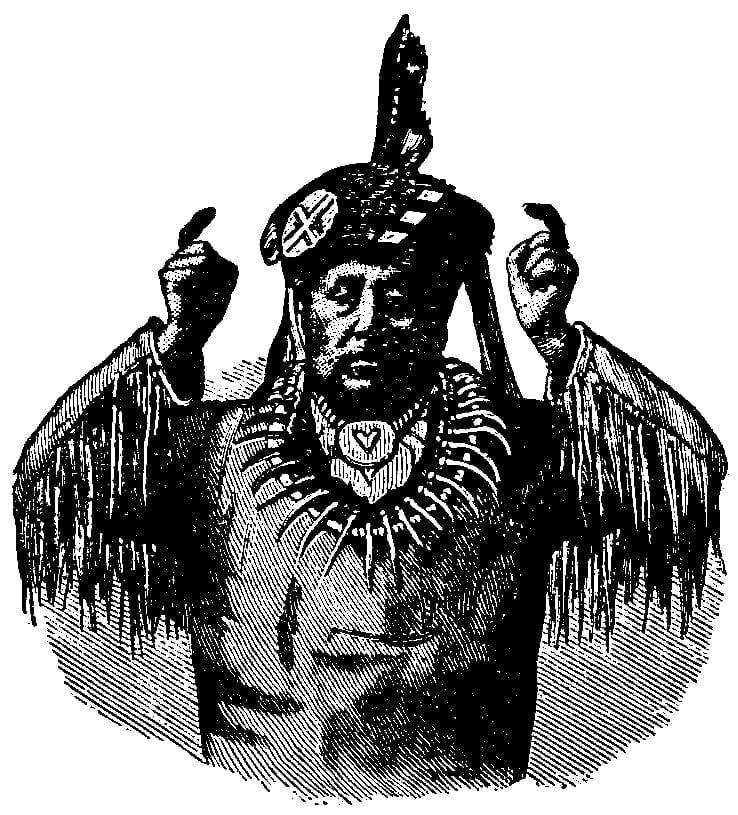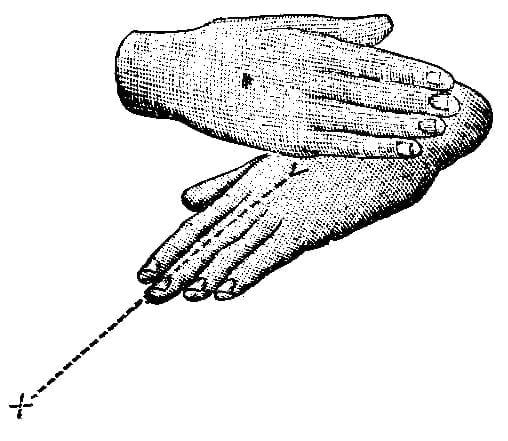Washington, City of
The sign for go by closing the hand (as in type position B 1) and bending the arm; the hand is then brought horizontally to the epigastrium, after which both the hand and arm are suddenly extended; the sign for house or lodge; the sign for cars, consisting of the sign for go and wagon, e.g., both arms are flexed at a right angle before the chest; the hands then assume type position (L) modified by the index being hooked and the middle finger partly opened and hooked similarly; the hands are held horizontally and rotated forward side by side to imitate two wheels, palms upward; and the sign for council as follows: The right arm is raised, flexed at elbow, and the hand brought to the mouth (in type position G 1, modified by being inverted), palm up, and the index being more open. The hand then passes from the mouth in jerks, opening and closing successively; then the right hand (in position S 1), horizontal, marks off divisions on the left arm extended. The sign for father is briefly executed by passing the open hand down and from the loins, then bringing it erect before the body; then the sign for cars, making with the mouth the noise of an engine. The hands then raised before the eyes and approximated at points, as in the sign for lodge; then diverge to indicate extensive; this being followed by the sign for council. (Oto and Missouri I.) “The home of our father, where we go on the puffing wagon to council.”
Missouri River
Make the sign for water by placing the right hand upright six or eight inches in front of the mouth, back outward, index and thumb crooked, and their ends about an inch apart, the other fingers nearly closed; then move it toward the mouth, and then downward nearly to the top of the breast-bone, at the same time turning the hand over toward the mouth until the little finger is uppermost; and the sign for large as follows: The opened right hands, palms facing, fingers relaxed and slightly separated, being at the height of the breast and about two feet apart, separate them nearly to arm’s length; and then rapidly rotate the right hand from right to left several times, its back upward, fingers spread and pointing forward to show that it is stirred up or muddy. (Dakota IV.)
Eagle Bull, a Dakota Chief

Place the clinched fists to either side of the head with the forefingers extended and curved, as in Fig. 298; then extend the left hand, flat, palm down, before the left side, fingers pointing forward; the outer edge of the flat and extended right hand is then laid transversely across the back of the left hand, and slid forward over the fingers as in Fig. 299. (Dakota VI; Ankara I.) “Bull and eagle’Haliaëtus leucocephalus, (Linn.) Sav.‘” In the picture-writing of the Moquis, Fig. 300 represents the eagle’s tail as showing the difference of color which is indicated in the latter part of the above gesture.


Rushing Bear, an Arikara chief
Place the right fist in front of the right side of the breast, palm down; extend and curve the thumb and little finger so that their tips point toward one another before the knuckles of the remaining closed fingers, then reach forward a short distance and pull toward the body several times ratter quickly; suddenly push the fist, in this form, forward to arm’s length twice. (Dakota VI; ArikaraI.) “Bear, and rushing.”
Spotted Tail, a Dakota chief
With the index only of the right hand extended, indicate a line of curve from the sacrum (or from the right buttock) downward, backward, and outward toward the right; then extend the left forefinger, pointing forward from the left side, and with the extended index draw imaginary lines transversely across the left forefinger. (Absaroka I; Shoshoni I; Dakota VI, VII; Arikara I.) “Tail, and spotted.”
Stumbling Bear, a Kaiowa chief
Place the right fist in front of the right side of the breast, palm down; extend and curve the thumb and little finger so that their tips point toward one another before the knuckles of the remaining closed fingers; then place the left flat hand edgewise before the breast, pointing to the right; hold the right hand flat pointing down nearer the body; move it forward toward the left, so that the right-hand fingers strike the left palm and fall downward beyond the left. (Kaiowa I.) “Bear, and stumble or stumbling.”
Swift Runner, a Dakota warrior
Place the right hand in front of the right side, palm down; close all the fingers excepting the index, which is slightly curved, pointing forward; then push the hand forward to arm’s length twice, very quickly. (Dakota VI; Arikara I.) “Man running rapidly or swiftly.”
Wild Horse, a Comanche chief
Place the extended and separated index and second fingers of the right hand astraddle the extended forefinger of the left hand. With the right hand loosely extended, held as high as and nearly at arm’s length before the shoulder, make several cuts downward and toward the left. (Comanche III.) “Horse, and prairie or wild.”

